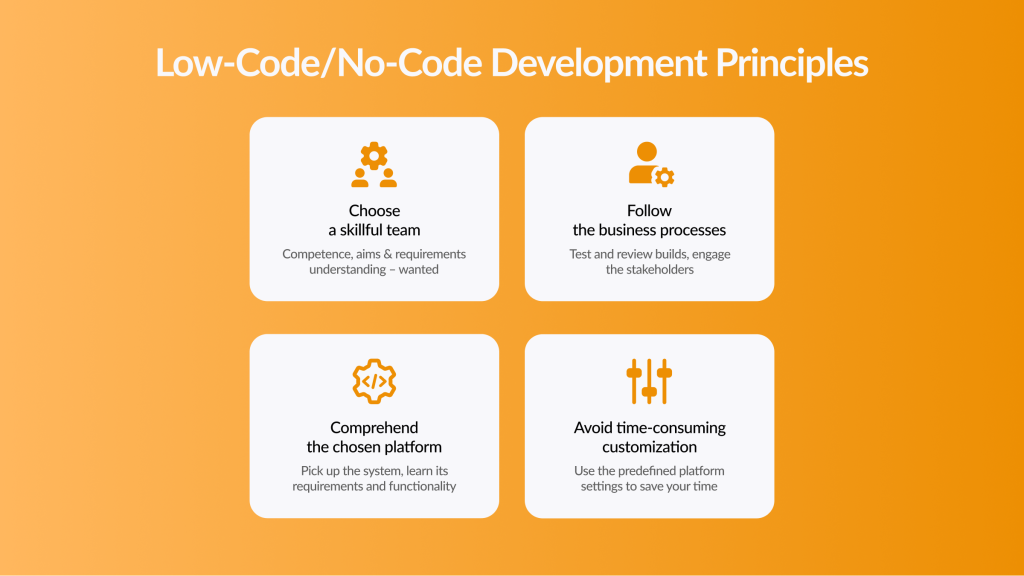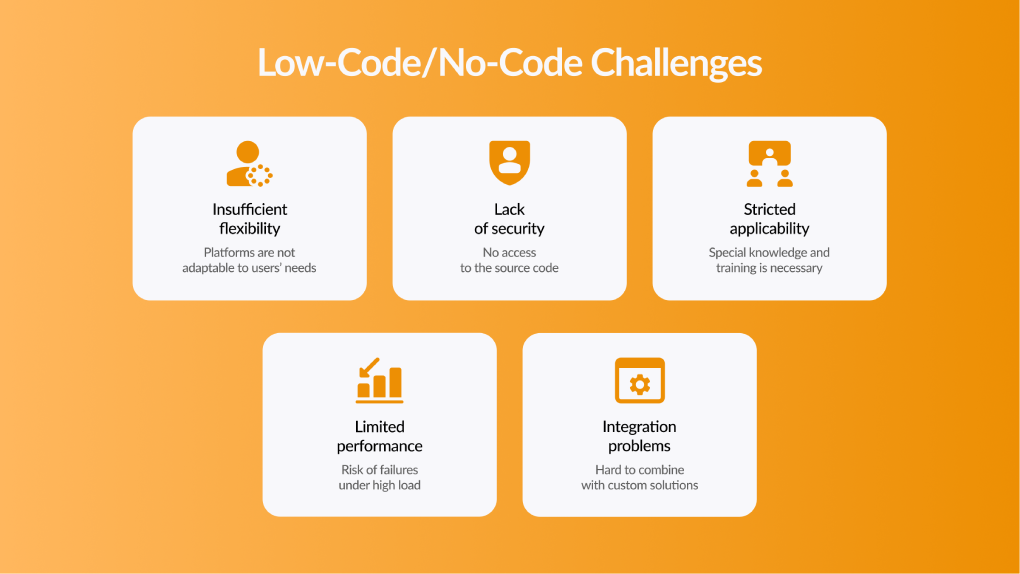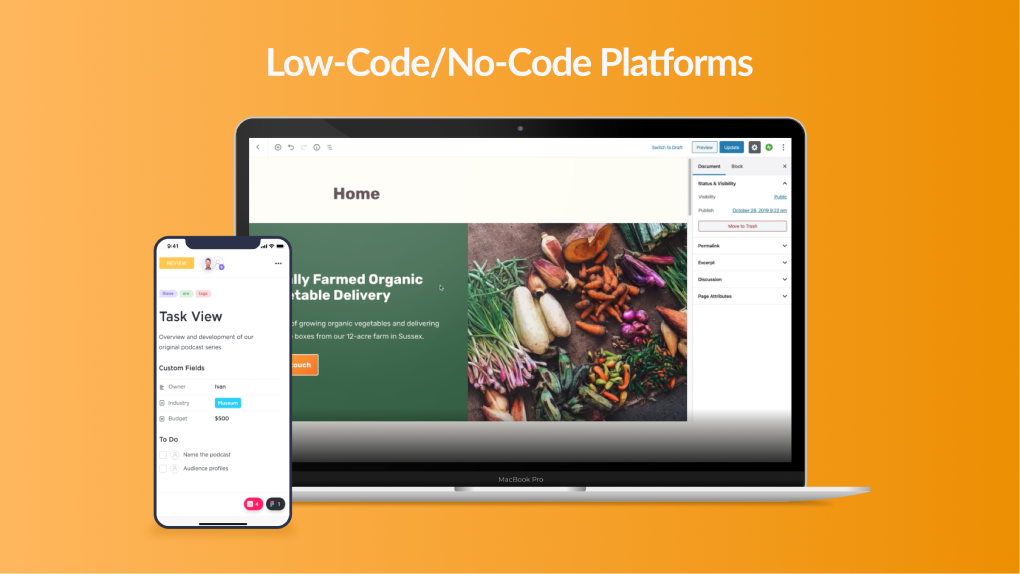Low code app development is a method of creating software applications using visual, drag-and-drop interfaces rather than traditional coding.
This approach allows developers with little or no coding experience to create complex applications quickly and easily, without the need for extensive programming knowledge.
According to a report from Markets and Markets, the low-code development platform market is expected to grow from $7.8 billion in 2020 to $45.8 billion by 2025, at a CAGR of 42.1% during the forecast period. The report attributes this growth to the increasing need for digital transformation and the shortage of skilled developers.
Additionally, a report from Research And Markets predicts the global low-code platform market will reach $18.1 billion by 2023, growing at a CAGR of 40.3% during 2018-2023. Let’s see what low code or no code development is and why it is a great option for many companies.
Table of Contents
What is Low Code App Development?
Low code platforms typically provide pre-built templates, modules, and libraries that can be easily assembled to create an application. These platforms also provide visual tools for creating user interfaces, connecting to data sources, and implementing business logic.
Development is that it allows organizations to reduce time-to-market by the optimized implementation, Quality Assurance, and application launching. This can help to reduce development time and costs, and can also enable organizations to more easily respond to changing business needs.
Low code app development is expected to continue to grow in popularity as more organizations look to digitize their operations and improve their competitiveness in the digital age.
When to Use a Low Code Platform?
Low code platforms are becoming increasingly popular among organizations of all sizes, as they offer a way to create complex software applications quickly and easily, without the need for extensive programming knowledge. However, not all projects are well-suited for low code development, so it’s important to know when to use a low code platform.
- Rapid application development. Low code platforms are ideal for projects that require rapid development, such as creating a minimum viable product (MVP) or responding to a business need quickly. With low code, you can create an application in a matter of weeks or months, rather than the traditional development cycle of months or years.
- Limited development resources. If your organization lacks the necessary development resources, such as experienced developers, a low code platform can be a great solution. By using a low code platform, non-technical stakeholders such as business analysts and product managers can create and maintain applications.
- Business process automation. Low code platforms can be used to automate repetitive business processes, such as expense reports, workflows, and approvals. By automating these processes, you can reduce errors and improve efficiency.
- Customizable solutions. Low code platforms are highly customizable and can be used to create a wide range of applications, including web apps, mobile apps, and internet of things (IoT) applications. It also allows easy integration with external systems, APIs and Databases.
See also: Improve Your User Experience with Search Quality Rating
Low code app development is not suitable for every project, and it’s important to evaluate your project’s requirements to determine if a low code platform is the right solution.
Nonetheless, if you need to create an application quickly, have limited development resources, or need to automate business processes, a low code platform may be the perfect fit.

Peculiarities and Benefits of Low Code Development
This approach offers a number of peculiarities and benefits that make it an attractive option for organizations of all sizes.
- User-friendly interface – Low code platforms are designed to be user-friendly, and can be used by developers and non-technical stakeholders alike. This allows organizations to involve a wider range of stakeholders in the development process, and ensures that the final application meets the needs of all stakeholders.
- Rapid development – Low code development can be used to create complex software applications quickly and easily. With pre-built templates, modules, and libraries, developers can assemble an application in a matter of weeks or months, rather than the traditional development cycle of months or years.
- Flexibility – Low code platforms are highly customizable and can be used to create a wide range of applications, including web apps, mobile apps, and internet of things (IoT) applications. They also allow easy integration with external systems, APIs and Databases.
- Cost-effective – Low code platforms are often more cost-effective than traditional development methods, as they reduce the need for expensive development resources and can be used to create applications quickly. This is highly beneficial when opting for custom software development.
- Reusability – Low code platforms allow developers to reuse existing modules, components, or templates for various projects which saves time and costs.
- Automation – Low code platforms can automate repetitive business processes, such as expense reports, workflows, and approvals, helping to reduce errors and improve efficiency.
- Low Code, high impact – Low code development allows organizations to easily create and deploy business-critical applications such as customer relationship management (CRM) systems, enterprise resource planning (ERP) systems, and workflow management systems.
- Speed – No-code app implementation can be used to create an application in a matter of weeks or months, rather than the traditional development cycle of months or years.
- Collaboration – No-code app development allows for easy collaboration between developers and non-technical stakeholders, such as business analysts, product managers, and end users. This can help to ensure that the final application meets the needs of all stakeholders.
Lastly, low code development is a versatile and cost-effective way to create software applications quickly and easily. With user-friendly interfaces, rapid development, flexibility, automation, reusability and the ability to create business-critical applications, low code development is pretty demanded and widely used these days.
The Best Low Code Development Platform: What to Choose?
When it comes to choosing a low code development platform, there are many options available on the market. However, not all low code platforms are created equal, so it’s important to choose one that best meets the needs of your organization. Here are some factors to consider when choosing a low code development platform:
- Ease of use – Look for a platform that is easy to use, with a user-friendly interface and drag-and-drop functionality. This will make it easy for both developers and non-technical stakeholders to create and maintain applications.
- Customizability – Choose a platform that offers a wide range of customizable options, such as templates, modules, and libraries. This will allow you to create a wide range of applications, including web apps, mobile apps, and internet of things (IoT) applications.
- Integration – The chosen platform should be able to integrate with other systems and platforms, such as databases, APIs, and third-party services. This will allow you to easily connect your applications to other systems and data sources.
- Scalability – As your organization grows, the platform should be able to scale with it. Look for a platform that can handle large amounts of data and users, and that can easily expand to meet the needs of your organization.
- Support and resources – The chosen platform should have a large community of users, with plenty of support and resources available. This will ensure that you have access to the help and resources you need to create and maintain your applications.
- Security – This point should be a top priority when choosing a low code development platform, as it will be handling sensitive data. Make sure the platform has robust security features and compliance certifications.
Some of the most popular low code development platforms are OutSystems, Salesforce, Appian, Mendix, and Microsoft PowerApps. Each of these platforms has its own unique features, so it’s important to carefully evaluate the needs of your organization and choose the platform that best meets those needs.
No-Code App Development: Preparation and Workflow
No-code app development is a method of creating software applications without the need for traditional coding. This approach allows non-technical stakeholders such as business analysts and product managers to create and maintain applications, without the need for programming knowledge.
1. Preparation
Before starting a no-code app development project, it’s important to clearly define the scope and requirements of the project. This includes identifying the key features and functionalities that the application needs to have, and determining the target audience and user experience. Once this stage is done, software project estimation is completed.
2. Workflow
The no-code app development workflow typically involves the following steps:
- Design. Use visual tools to create the user interface and layout of the application.
- Connect. Connect the application to data sources and external systems using pre-built connectors and APIs.
- Configure. Configure the application’s logic and behavior using pre-built modules, templates, and libraries.
- Test. Test the application to ensure that it meets the requirements and that it functions as expected.
- Deploy. Deploy the application to a production environment, such as the web, mobile, or cloud.
- Monitor. Monitor the application’s performance, and make any necessary updates and improvements.

Summarize
No-code app development is a powerful tool for businesses of all sizes, as it allows them to rapidly and simply design, test, and deploy their products having limited resources and time. By following a clear preparation and workflow process, organizations can ensure that their no-code app development projects are successful.



